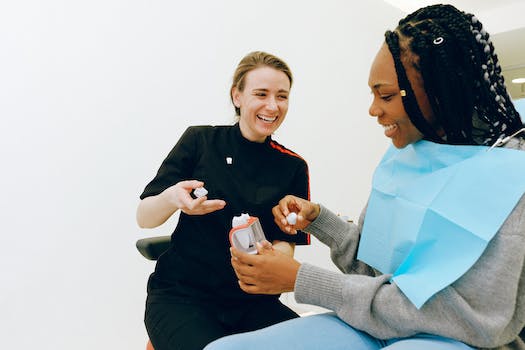Introduction: Understanding the Concept of Collaboration in Dental Care
Welcome to our blog! Today, we’re exploring the vital role of collaboration in dental care. Simply put, collaboration in dental care means different dental professionals working together to provide the best possible treatment for a patient. This team can include general dentists, orthodontists, periodontists, and even medical doctors, all working together to ensure a comprehensive approach to your oral health. This cooperative effort allows professionals to share their expertise and knowledge, leading to a more accurate diagnosis, efficient treatment plan and ultimately, improved patient outcomes. So, let’s delve deeper into the importance of this team effort in maintaining your pearly whites!
The Role of Interdisciplinary Collaboration in Dental Healthcare
Interdisciplinary collaboration plays a vital role in dental healthcare. It involves the teamwork of various specialists, like dentists, hygienists, orthodontists, and oral surgeons, to provide comprehensive dental care. This collaboration ensures that every aspect of a patient’s oral health is addressed, from basic dental hygiene to complex procedures. It fosters communication among the team, which helps in creating a tailored treatment plan for each patient. By working together, these professionals can offer a higher standard of care, leading to better patient outcomes. Hence, collaboration is not just beneficial, but essential in the field of dental healthcare.
How Collaboration Enhances Patient Care in Dentistry
Collaboration plays a crucial role in enhancing patient care in dentistry. When dental professionals work together, sharing knowledge and expertise, the quality of patient care significantly improves. For instance, a general dentist may collaborate with an orthodontist or periodontist to provide comprehensive treatment for a patient with complex dental issues. This team approach ensures that patients receive the most effective and appropriate care, leading to better oral health outcomes. Moreover, collaboration promotes clear communication, which helps in aligning treatment plans with the patient’s needs and expectations. Therefore, collaboration in dental care is not just beneficial, but essential for providing top-notch dental care.
The Importance of Communication in Collaborative Dental Care
Effective communication is absolutely vital in collaborative dental care. It ensures all dental professionals involved in a patient’s care are on the same page, enhancing treatment planning, decision making, and overall service delivery. For instance, a dentist may need to communicate with a hygienist about a patient’s oral health status, or with a dental surgeon about the best approach for a complex extraction. Good communication helps avoid misunderstandings and errors, leads to better patient outcomes, and contributes to a more efficient and harmonious working environment. Therefore, it’s clear that strong communication skills are just as important as clinical skills in delivering high-quality dental care.

Case Studies: Successful Collaborative Approaches in Dental Practices
In the world of dentistry, collaboration plays a crucial role in achieving optimal patient outcomes. Several case studies have demonstrated successful collaborative approaches in dental practices. For example, a dental hygienist, dentist, and oral surgeon working together can create a comprehensive treatment plan for a patient with complex dental issues. This multidisciplinary approach ensures each aspect of the patient’s dental health is addressed effectively. It also promotes a smoother and more efficient workflow, leading to improved patient satisfaction. These case studies underline the importance of teamwork and communication in delivering high-quality dental care.
The Impact of Collaboration on Dental Care Quality and Patient Satisfaction
Collaboration in dental care can greatly enhance the quality of services and boost patient satisfaction. When dental professionals work together, they can share knowledge, skills, and experiences, leading to improved diagnosis and treatment plans. They can tackle complex dental issues more effectively and efficiently, ensuring patients receive the best possible care. This collaborative approach also fosters a more comfortable and reassuring environment for patients. They feel more confident in the care they receive, knowing that a team of experts is working together for their oral health. Therefore, collaboration doesn’t just improve dental care quality, it also significantly increases patient satisfaction.
Overcoming Barriers to Effective Collaboration in Dental Care
Overcoming barriers to effective collaboration in dental care is critical for ensuring optimal patient outcomes. Communication is the key. Dentists, hygienists, and other dental professionals need to establish clear, open lines of dialogue. This not only helps in discussing patient cases but also in coordinating treatments. Equally important is the understanding of each team member’s roles and responsibilities. This eliminates confusion and fosters mutual respect. Additionally, regular team meetings can be held to discuss patient progress and plan future treatments. By breaking down these barriers, dental teams can work together more effectively, enhancing the quality of care provided to patients.

The Future of Collaborative Dental Care: Emerging Trends and Technologies
The future of collaborative dental care is set to be revolutionized by emerging trends and technologies. Digital advancements are fostering greater cooperation between dental professionals, leading to improved patient outcomes. For instance, technologies like 3D printing and tele-dentistry are enabling dentists to provide more accurate diagnoses and personalized treatment plans. Moreover, the rise of cloud-based software is facilitating seamless communication and data sharing among dental teams, ensuring everyone is on the same page regarding patient care. In essence, these technological innovations are taking collaboration in dental care to new heights – enhancing efficiency, precision, and patient satisfaction.
Training and Education: Preparing Dental Professionals for Collaboration
Training and education play a pivotal role in preparing dental professionals for collaboration. Dentistry is not a solo act – it involves a team of professionals working together to provide the best patient care. This includes dentists, dental hygienists, dental assistants, and even administrative staff. In-depth training and comprehensive education programs are essential to equip these professionals with the skills to work together effectively. These programs not only focus on individual roles but also on how these roles intertwine in a collaborative environment. Through this, dental professionals learn to communicate, coordinate, and cooperate seamlessly, ensuring smoother procedures and better patient outcomes. This collaboration is not just a nice-to-have, but a must-have in modern dental care.
Conclusion: Embracing Collaboration for Improved Dental Healthcare Outcomes
In conclusion, embracing collaboration in dental healthcare can significantly improve patient outcomes. When dentists, hygienists, dental assistants, and other healthcare professionals work together, they can provide a comprehensive approach to patient care, leading to better diagnosis and treatment. This team-based approach also fosters a more patient-friendly environment, resulting in improved patient satisfaction and adherence to treatment plans. Therefore, it’s vital for dental care providers to prioritize collaboration for the betterment of overall dental health.

